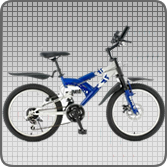| TEL: | 86-319-7980163 |
| 86-13576783980 | |
| 86-18931959102 | |
| FAX: | 86-319-7980163 |
| email: | edwin@sunrisingcn.com |
| MSN: | sunrising168@hotmail.com
|
| skype: | sunrising8866 |
|
Making sure your bike fits |
|
time: 2010-8-26 11:14:17 |
| These tips are intended for bike commuters (especially novice commuters), not racers or mountain bikers. Upright bicycles are really not good for your body -- they place a lot of stress on various parts of your body. If you're riding for an hour or less at a time on a properly-fitted bike, you probably won't be riding for long enough for that to matter. But if you're riding for longer periods of time, or if you're older, or if you're concerned by recent reports of damage to private parts by cycling, then you should consider getting a recliner bike. The tips below are for upright bikes. Frame Size. Getting a bike whose frame matches your body is the most important part of bike fit . If the frame size is wrong, you probably won't be able to adjust the seat and handlebars enough to compensate. When you're straddling the bike with both feet on the ground, there should be at least 1-2 inches between the top tube and your crotch. If there's less space, you're going to hurt yourself at some point when you hop off the seat to stop. If there's a LOT more than 1-2 inches, then whether your bike will fit will depend on how far up you're able to move your seat and handlebars. Seat Height. When you're pedaling and your leg is all the way down (pedal is in 6:00 position), your knee should be slightly bent. If your leg is straight (knee locked), your seat is too high. If your knee is very bent (as in the illustration above), your seat is too low. Either problem can hurt your knees, and a seat height that's too short robs you of power and makes it harder to ride. Just loosen the bolt under the seat and raise or lower the seat. (There are vertical hash marks in a ring around the seat stem that indicate the maximum you can safely raise the seat.) If you can't raise the seat high or low enough, your bike is the wrong size and you need another bike. Note that the guy in the picture above has a seat height that's a little too low. You can't see the angle of his right leg clearly because it's on the other side of the bike, but we can also tell that his seat's too low because his left leg is completely level when it's in the 12:00 position. Instead, it should not come up quite so far, and should angle down slightly. (If anyone's got a better picture, I'd love to have it.) Note that if you raise the seat, you'll probably also need to raise the handlebars, as per below. Seat Angle. You may be tempted to have your seat tilt down so there's less pressure on your crotch, but don't. If your seat tilts down, gravity will be pulling you off the front of your bike and pushing you into your handlebars, and you'll place a lot of stress on your fingers, wrists, arms, and neck to keep you pushed back onto the seat. Keep your seat level, or even tilted one or two notches up for men's seats. If your seat is uncomfortable when it's level, it may be too high. Try lowering it. If you're riding for more than 1 hr. at a time, you're liable to get sore no matter what. People doing this much riding should definitely consider a comfortable recliner bike or ergonomic seat pads. Seat Position (front & back). The nose of the saddle should be behind the bottom bracket. If it's above or in front of the saddle then you have to pedal directly underneath or behind you, robbing you of efficiency. Also, in normal riding position with the pedals parallel to the ground, your front knee (from almost the front edge) should be directly over the pedal spindle (the middle of the pedal). This avoids knee pain. Handlebar Style. Mountain bike- or cruiser-style handlebars allow you to sit upright without hunching over your handlebars, like you have to do with old-style 10-speed handlebars. Hunching over is uncomfortable, reduces your visibility, and makes you more likely to fly over your handlebars if you have to stop fast. If your bike has old 10-speed style handlebars, you can get a bike shop to put modern handlebars on it, without having to trade in your whole bike. Some riders also prefer to install cruiser-style handlebars. Handlebar Height. Your handlebars should be at least as high as your seat, or even above it, so you can ride upright. If your handlebars are lower than your seat you'll be pushed into your handlebars, and you'll place more stress on your wrists, arms, neck, and back. Most handlebars can be raised by loosening the screw on the top of the handlebar stem with an allen wrench a few turns and then tapping it with a hammer to release the mechanism inside. There are vertical hash marks in a ring around the handlebar stem that indicate the maximum you can safely raise the stem. If you have to raise the handlebars a lot, there may not be enough slack in your brake and shifter cables to raise the stem as much as you want, and you may therefore need to install new brake and shifter cables (or have a bike shop do it for you). Remember earlier when we said our illustrated guy should raise his seat? Well, notice that when the seat goes up, it will be higher than the handlebars, so he'll need to raise the handlebars, too. |



